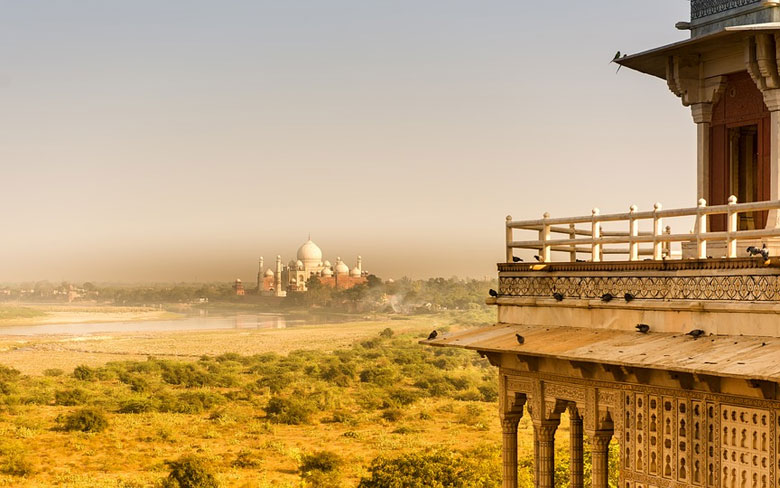Spread out across the plains of the Ganga, the great state of Uttar Pradesh contains some of the most sacred sites of Buddhist and Hindu culture
Uttar Pradesh, with 166 million inhabitants, would be the seventh most populous country in the world if it were independent. As it is, the state is the heartland of the world’s largest democracy and politics here are often lively. UP has a broad industrial base but is still predominantly agricultural with wheat, maize, rice and sugarcane among the main crops.
Uttar Pradesh, meaning “northern state”, is made up of two regions. The largest part of the state covers the rich, alluvial plain of the Ganga and its tributaries. To the south are the Vindhya hills and the plateau of peninsular India.
Although UP is famous worldwide for the Taj Mahal at Agra, it also attracts devout Hindus to the many pilgrimage places along the River Ganga, which flows through the holy cities of Allahabad and Varanasi. Buddhists are drawn to the deer park at Sarnath where the Buddha preached his first sermon. Fifteen percent of UP’s population is Muslim and in addition to historic mosques and Sufi shrines, UP is home to some of the most prestigious Muslim theological colleges and Aligarh Muslim University.
Tourist Information on Agra
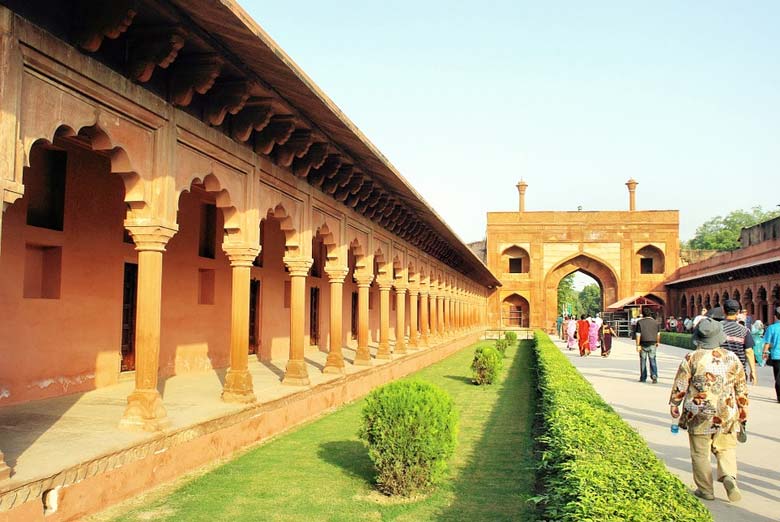
Agra
The old part of Agra 1, 204 km (127 miles) southeast of Delhi, is still like a medieval city, with narrow lanes and colourful shops selling local handicrafts, especially gold and silver thread embroidery and imitation Mughal inlay on marble. Among its culinary specialities is petha, crystallised pumpkin. The city achieved greatness first under the Mughals, and particularly the emperors Akbar (1556-1605), Jahangir (1605-27) and Shah Jahan (1628-58).
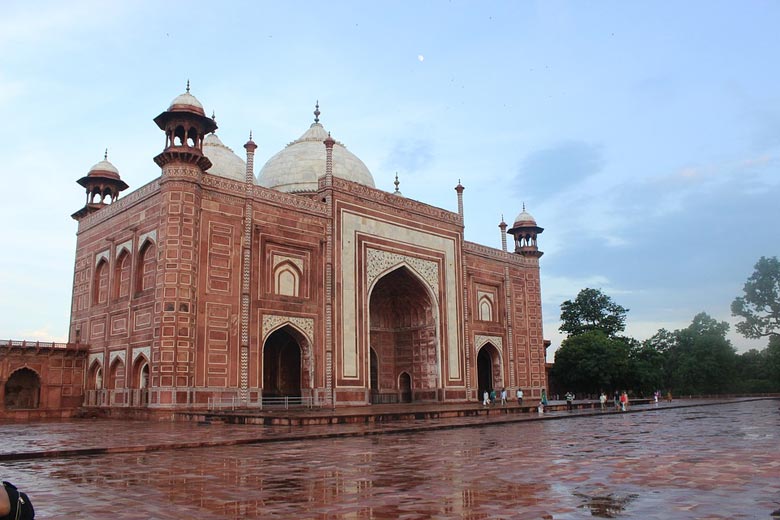
Agra Fort
Agra Fort, on the banks of the River Yamuna, began to take shape from 1564. Akbar constructed the 2.4-km (11/2-mile) surrounding walls of local sandstone. Of Akbar’s “500 edifices of red stones in the fine styles of Bengal and Gujarat” only the Jahangiri Mahal still stands. This was the main part of the women’s quarters, constructed in a local Indian style to suit the needs of the emperor’s Hindu wives. Akbar’s other buildings were demolished to make way for the imperial quarters of Shah Jahan, combining Hindu and Islamic styles of architecture. The Mussaman Burj (Octagonal Tower) is said to be the place where Shah Jahan lay on his deathbed gazing out at the Taj Mahal.
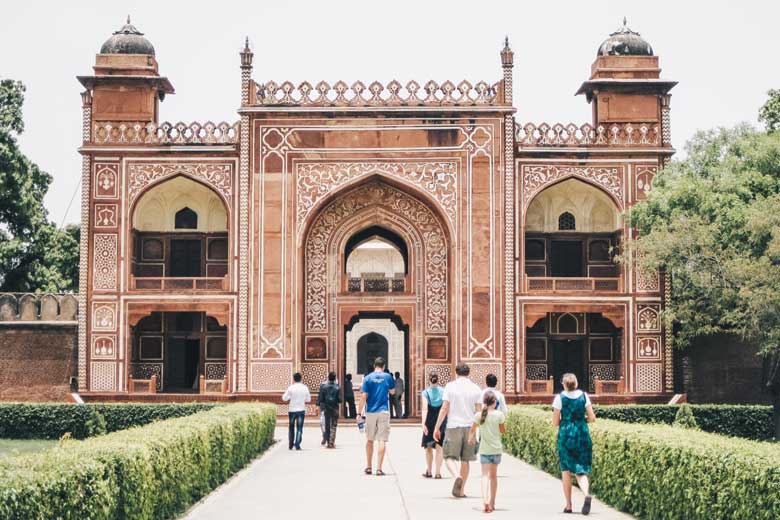
Itimad-ud-Daula
The tomb of Itimad-ud-Daula, across the river from the fort, is the most intimate of the three great monuments in Agra. Itimad-ud-Daula was father-in-law and vazir (principal minister) to Emperor Jahangir. Nur Jabal’, Jahangir’s queen, undertook the construction of her father’s tomb (1622-28) using white marble inlaid with coloured stone. Also on the east side of the river, hidden behind the lovely nurseries along Aligarh Road, are the Chin’ ka Rauza, the tomb of Afzal Khan, a courtier to Jahangir and Shah Japan, and, further on, the Aram Bagh, gardens believed to have been laid out by the Emperor Babur (both sites open sunrise—sunset).
Within sight of Agra Fort, the Taj Mahal (open Sam-5pm; entrance fee, extra charge for dawn and sunset visits, free on Fri) stands in a formal Mughal garden on a terrace beside a bend in the Yamuna. It is the tomb of Mumtaz Mahal, wife of Emperor Shah Jahan. She was married to Shah Jahan for 19 years, during which she accompanied him on his military campaigns and shared his cmitideoce on all matters of state. She bore 13 children, seven of whom, including the next emperor, Aurangzeh, survived into adulthood. In 1631 she died in childbirth. Shah Japan was desolate and built the Taj Mahal in her honour. Ile was later deposed by Aurangzcb and imprisoned in Agra Fort.

Fatehpur Sikri
Fatehpur Sikri: Akbar’s capital
Early morning, is the befit nine to visit Fatchpur Sikri , Akbar’s imperial capital, 35 km (20 miles) southwest of Agra. The well preserved remains of the city include the palace and the royal Jami Masjid (mosque) where the Sufi saint Shaikh Salim Chishti is buried. Akbar is said to have visited the saint on this site when he was anxious for an heir. He was told that he would have three sons and when his words came true Akbar chose Sikri for his capital.
Fatehpur, “town of victory”, was built of sandstone quarried from the hill on which it stood. It was only occupied for 14 years before Akbar shifted his capital to Lahore. Everyone at Fatehpur Sikri will tell you that it was because the water ran out, but it may also have been for strategic reasons. The palace buildings draw on the style of local Indian architecture, with the craftsmen replicating wooden houses in stone. The finest monuments include Diwan-e-Khas where Akbar debated religious matters; the Turkish sultan’s house with its minute carvings; Madam’s house with its wall paintings; and the Jami Masjid.
Akbar also designed his own resting place on earth. The tomb, completed in 1613, is at Sikandra, 12 km (7 miles) nonhwest of Agra. The mausoleum is four storeys high; the first three arc of red sandstone, the fourth of white marble containing the fake tomb of the emperor. The real tomb, as in all such mausoleums, is in a crypt below. Blackbuck wander in the formal gardens.
Krishna Country – Mathura
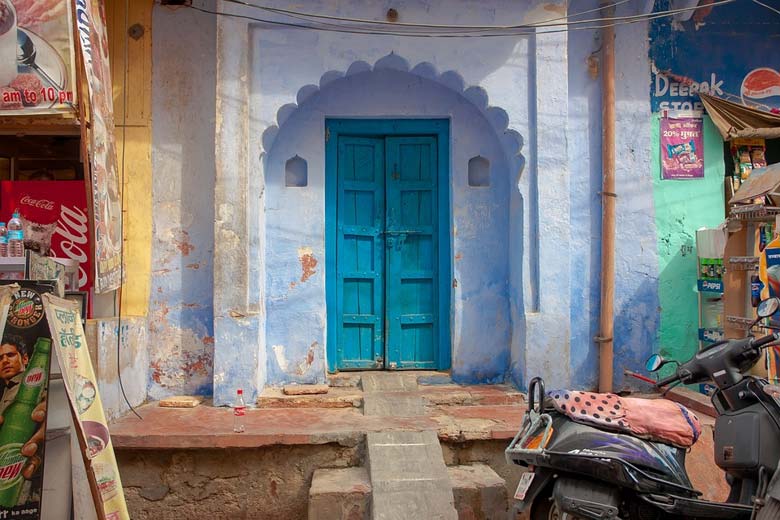
Mathura
The area around Mathura , on the banks of the River Yamuna, 30 km (19 miles) north of Agra on the Delhi road, is known as Braj and is popularly believed to have been the birthplace and borne of Lord Krishna, w ho in one of Lord Krishna, who in one of the greatest Ilindu texts, the Bhagavad Gita, explains the world and how best to live in it. According to legend, the young Krishna was brought up in a family of cowherds, where he performed miracles for the good of the villagers, and played tricks on them, and where all the gopis (milkmaids) fell helplessly in love with him. He was, Hindus believe, an incarnation of the god Visnu.
Mathura today is an industrial town notable for its oil refinery. Pilgrims still gather to bathe at the ghats on the banks of the Yamuna and to visit temples such as the Dwarkadhish shrine in the crowded marketplace.
Around the town are numerous sites associated with Visnu. The most impressive is Vrindavan, 10 km (6 miles) north of Mathura, home to many Hindu widows who earn a tiny sum each day singing hymns to the Lord. Among the fine temples are those to Govind-dev (1590); Jugal Kishor, Radha-Vallabh and Madan-Mohan (17th century); Ranganathji and Shahji (19th century); the Vankehehari shrine; the temple of Pagal Baba and that of the International Society for Krishna Consciousness. Mathura was once a thriving centre of Buddhism and Janism. Sculptures made by local artists between the 2nd century BC and the 6th century AD are on display at the museum (open 10.30am-4.30pm; Apr-Jun 7.30am-12.30pm; closed Mon).
Southern Uttar Pradesh
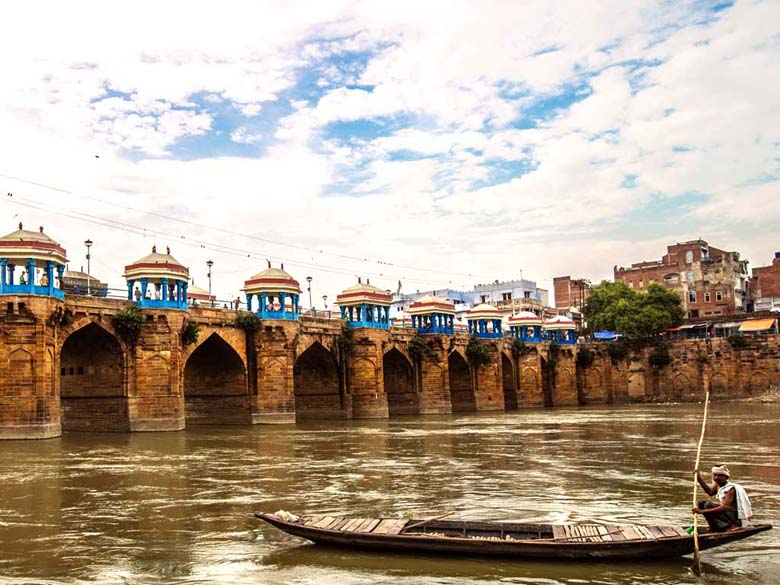
Uttar Pradesh
The area bordering Madhya Pradesh can be explored from Jhansi , 188 km (117 miles) south of Agra. Jhansi is dominated by its hill fort (dawn-dusk), from where the Rani of Jhansi, one of the heroines of the popular uprising against the British in 1857, directed her operations. There is a museum here (10.30am-4.30pm, closed Mon).
From Jhansi it’s a three-hour drive east to the village of Khajuraho (actually in Madhya Pradesh), renowned for its 1,000-year-old temples and erotic carvings. The pilgrimage centre of Chitrakut, 235 km (146 miles) east of Jhansi, looks like a mini-Varanasi, with ghats on the banks of the narrow Mandakani River.
Central and Eastern UP
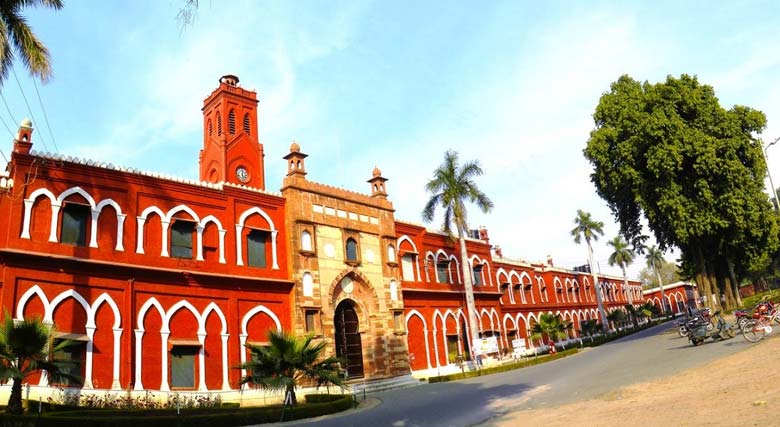
Aligarh
The route from Delhi, 446 km (277 miles) east to the state capital of Lucknow, passes through Aligarh, site of the Aligarh Muslim University founded by Sir Syed Ahmad Khan in 1975 to provide the Muslim community of India with a modern, scientific education.
Kanpur, on the Ganga 70 km (44 miles) southwest of Lucknow, is the state’s leading industrial city. In the uprising of 1857 the British garrison at Kanpur was besieged by Indian forces, and in the face of starvation agreed to an offer of safe passage. As they crossed the river bank they were massacred. All Souls’ Memorial Church (1875) contains the names of those who died.

Lucknow
Tourist Information on Lucknow
The state capital Lucknow , an hour’s journey north from Kanpur, stands on the Gomati River, a tributary of the Ganga. It was once a city of gardens, but many have disappeared under offices, shopping centres and residential colonies.
Lucknow is still a compact city with a relaxed atmosphere. Hazratganj, the main street, gives its name to the most popular activity here of ganjing – sauntering, shopping and snacking. At one end of Hazratganj are the domed State Legislative Assembly and the Governor’s House, both British Raj buildings. At the other is the road leading to the ruins of the Residency, where in the 1857 uprising, the British were besieged for 87 days.
In this area are some of the monuments to Lucknow’s golden era, when it Was the capital of the Mughal province of Avadh (Oudh). As the Mughal empire waned, the rulers of Avadh became more independent and in the 18th century established a dynasty of their own. The Nawabs of Avadh were Shia Muslims and gave great importance to Muharram, the anniversary of the martyrdom of the Prophet’s grandson Imam Hussain. Many of the remaining historic buildings are imambaras (houses of the Imam) where poetry in memory of the Imam and those martyred with him is recited during Muharram.
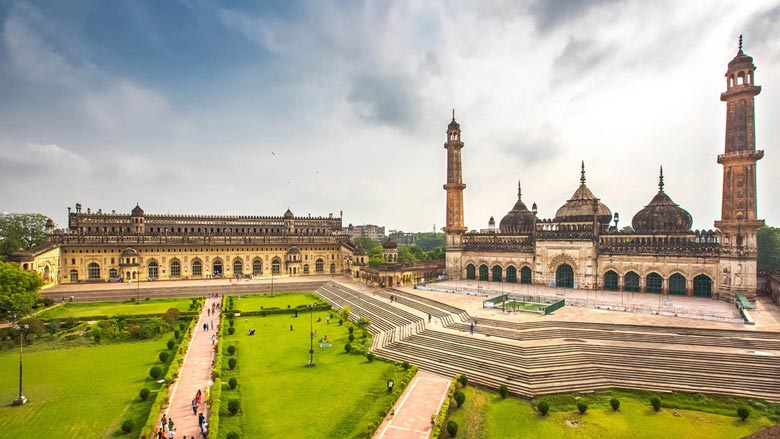
Lucknow
The Lucknow court drew scholars, artisans, painters, poets, musicians and dancers. Among the most impressive remaining Nawabi buildings are the domed tombs in Begum Hazrat Mahal Park at the end of Hazratganj, and the nearby imambara of Shah Najaf next to the Botanical Gardens. Further on is the Great Imambara (open 8am-6.30pm; closed during Muharram); it has one of the largest vaulted apartments in the world. It was built in 1784 as a food-for-work relief measure during a famine. Above the magnificent hall is a labyrinth (bulbhulaiya). Many of the coloured glass candleshades and other decorations have been lost over the years, but those at Husainabad Imambara (open 6am-5pm) are still preserved. Here two side pavilions, like miniature Taj Mahal’s, are reflected in pools in a formal garden.
One of the most extravagant buildings or me period is La Martiniere School, known simply as La Mares, which stands in its own extensive grounds. It was built by the French adventurer Claud Martin, who is buried here (open by arrangement with the principal).
No trip to Lucknow is complete without a visit to the old city at Chowk and a walk in the surrounding alleys where there are innumerable shops selling the city’s chikan embroidery, a legacy of the Nawabs. Lucknow’s State Museum (open 10.30am-4.30pm; closed Mon) houses statues and friezes from the 1st-11th century, rare coins and an Egyptian mummy.
Traveling east
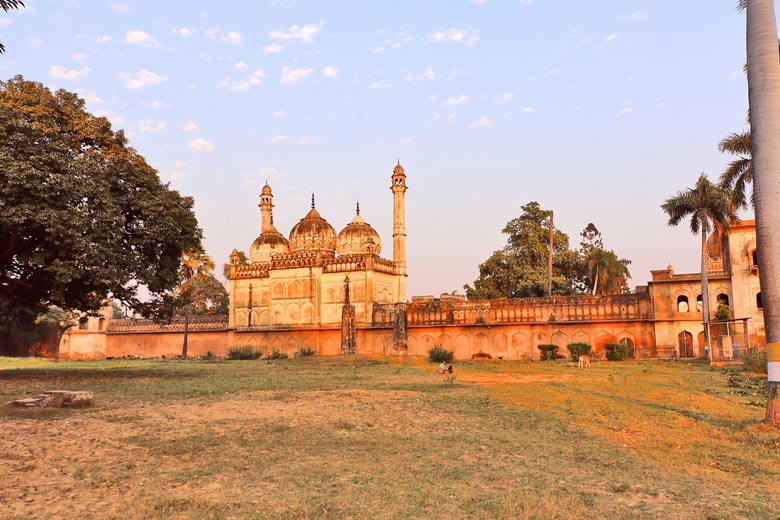
Faizabad Tourism
The influence of the Nawabs is also apparent at Faizabad , 150 km (93 miles) east of Lucknow, and for a while the capital of the province of Avadh. This busy town has fine monuments, including Bahu Begum s tomb and Gulab Bari, the mausoleum of one of the first rulers of Avadh, Shuja-ud-Daula.
Six kilometres (4 miles) further east is the temple town of Ayodhya, standing on the banks of the Ghaghara River. This is believed by Hindus to be the capital and birthplace of Lord Rama, another incarnation of Visnu and hero of the Ramavana epic.
Popular devotion to Rama increased in the 161 century after Goswami Tulsi Das wrote his great version of the Ramayana in Avadhi — the language of the people. The Nawabs of Avadh and their courtiers gave donations to various temples, and the oldest and most beautiful buildings of Ayodhya standing today date from this period. One of the most notable is Hanumangarhi, the fort of Hanuman, built to the monkey god, greatest devotee of Rama, and Sita. Steep steps lead up to the main temple and an army of real monkeys ready to snatch offerings from pilgrim’s hands (temple enclosure open dawn—dusk). It is run by an order of celibate ascetics, who have a militant history and are still fond of wrestling.
The peace of this town was broken in 1992 when Hindu extremists demolished a mosque that they believed stood on the exact birthplace of Rama. There is now a heavily barricaded, makeshift temple on the spot, Ram Janambhoomi.
Gorakhpur, 130 km (80 miles) east of Faizabad, is named after Guru Gorakhnath, a pre-medieval saint, whose temple and matha (monastery) stand here. The temple is especially worth visiting during the Khichri Mela, climaxing on 14 January each year. Villagers come to offer rice and lentils, which are thrown on to a pile in front of an image of the saint.
Land of Buddha
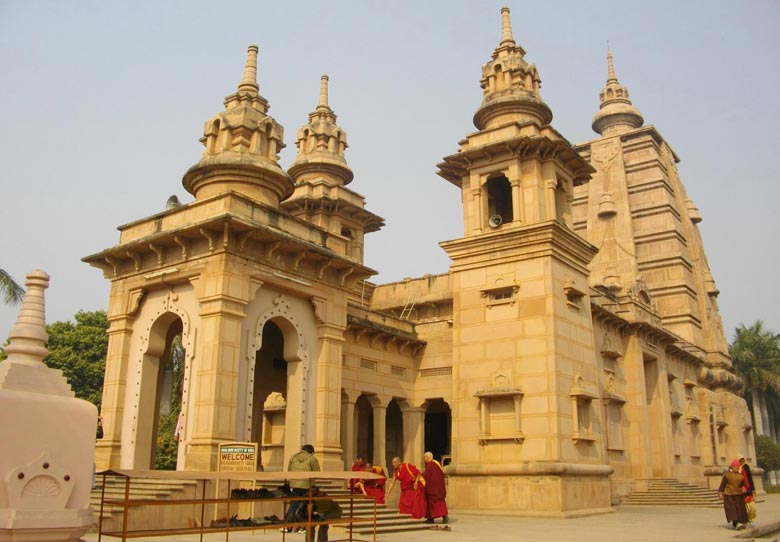
Muktabandhana stupa
Khushinagar, 53 km (33 miles) east of Gorakhpur, is identified as the spot Where the Buddha left this world and attained parinirvana in the 5th or 6th century BC. Here the Muktabandhana stupa is said to have been built to preserve the relics of the Buddha by the Mallas who ruled the area at the time he died. A smaller shrine nearby contains a reclining statue of the Buddha. Other Buddhist pilgrimage sites within reach of Gorakhpur are Piprahwa, 90 km (56 miles) away, where the Buddha spent the early years of his life, and Lumbini, 8 km (5 miles) across the border with Nepal, where he is believed to have been born. To the west, near the Nepal border, is Sravasti where the Buddha spent 25 rainy season days. The founder of the Jain religion, Lord Mahavira, a contemporary of Buddha, was also a frequent visitor to Sravasti. Two Ashokan Pillars stand at the gate of the Jetavana, the excavated ruins here.
Tourist Information on Allahabad
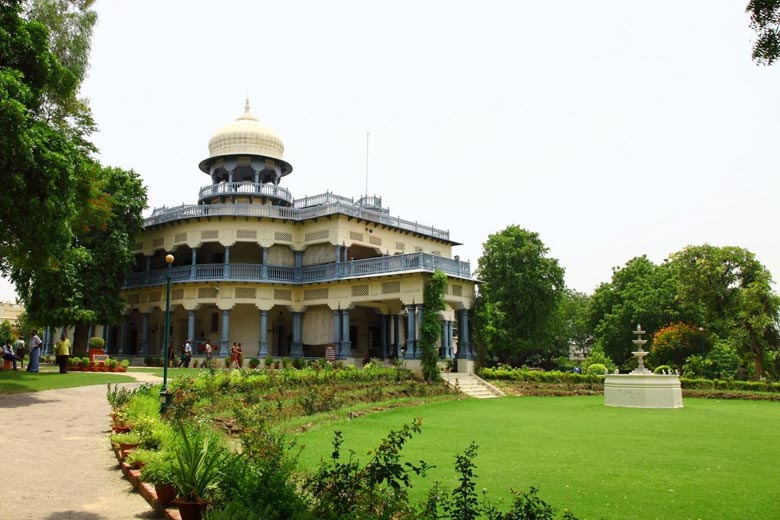
Allahabad
One of the most sacred places of Hinduism is Allahabad , 188 km (117 miles) southeast of Kanpur. Here the Yamuna flows into the Ganga. Hindus believe the invisible River Saraswati joins the Ganga at this point. Allahabad is known as “Tirth Raj”, the king of pilgrimage places. At the sacred confluence a religious fair, the Magh Mela, is held each January and February, and once every 12 years the greatest religious festival of northern India, the Mahakumbh Mela takes place. To bathe at the confluence at the most sacred times is said to wash away the sins of many births. Rowing boats will take you to the spot where the milky waters of the Ganga meet the blue waters of the Yamuna.
Allahabad city is crowded and somewhat dilapidated. Preserved for the nation is Anand Bhavan (open 8.30am-5.30pm, closed Mon), home of the Nehru family and a nerve centre of the independence movement.
At Kausambi, 45 km (28 miles) from Allahabad, are the ruins of one of the great metropolitan forts that were established in India during the first millennium BC. Courtyard houses were protected by massive walls of burnt brick. Kausambi was occupied from the 8th century BC to the 6th century AD. Its main Buddhist stupa measured 25 metres (80 ft) across.
Tourist Information on Varanasi
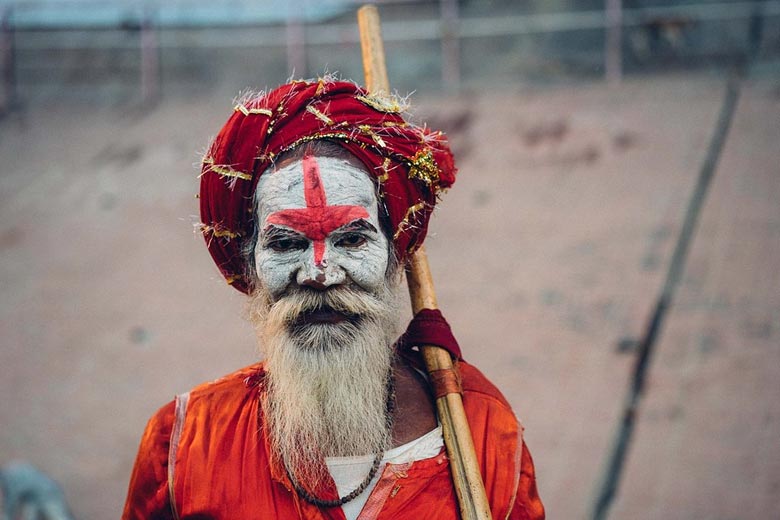
Varanasi
The most sacred stretch of the Ganga is at Varanasi , (Bemires), one of the oldest living cities in the world. For more than 2,500 years it has attracted seekers and pilgrims. The heart of the city lies between the streams of the Varuna and the Assi which flow into the Ganga Varuna and Assi together form the name Varanasi. But the city’s other name, “Kashi”, probably derives from the Sanskrit “to shine or look brilliant”. That light is the god Siva’s, Varanasi is his home.
Siva literally means auspiciousness or happiness and, according to a local saying, every single pebble and stone in Kashi is Siva. To his devotees, Siva is the one great God. To die here in his city on the banks of the holy river is to achieve moksha, liberation from the cycle of life and death. Death is not hidden in India. It is part of life. This is one reason you find cremation grounds in the very centre of Varanasi.
Here, dawn on the Ganga is one of the most fabulous sights in India. The river flows south to north, with the city on the west bank, and fields and trees to the east. As the sun rises, the golden rays fall on the innumerable temples and 70 bathing ghats, on the priests under their tilted umbrellas, and devout Hindus taking a purifying dip. The one notable mosque on the skyline was built by the Mughal Emperor Aurangzeb. Rowing boats take visitors along the ghats from Assi in the north to Raj Ghat.
Within the city, the Vishwanath temple, built in the late 18th century, is the main Siva sanctuary. It is closed to non-Hindus, but visitors can climb surrounding buildings to see the gilded dome. If Siva is king of Varanasi, the god-dess Annapurna is queen. Her temple is close to Vishwanath’s. She is the perfect mother, a gentle goddess, who provides food (anna) and life. Another of the city’s busiest temples is in the south and dedicated to Durga, one of its fierce goddess guardians. The temple is often called the monkey temple because of the hordes of red macaques who’ve made it their home.
Nearby is the most popular shrine to the monkey god Hanuman, the Sankat Mochan. One of Hanuman’s main strengths is to turn away difficulties, and on Tuesdays and Saturdays devotees gather to ask for his help. The chief priest lives in a house overlooking the Ganga on Tulsi Ghat where Goswami Tulsi Das is said to have written his Ramayana epic.
Across the river is Ramnagar, home of Kashi Naresh, the Raja of Benares, whose fortress houses a private museum (open 9am—noon, 2-5pm). He is the patron of the Ramnagar Ram Lila, an enthralling traditional month-long enactment of the Ramayana, performed in October and November.
About 6 km (4 miles) to the north of Varanasi is Sarnath, the deer park where the Buddha preached his first sermon after attaining enlightenment, and returned to spend the rainy season several times during his life. It is one of the most important Buddhist pilgrimage sites. Most impressive of the ruins is the Dhamekh Stupa, which is said to mark the exact spot where the Buddha preached, and an Ashokan pillar (3rd century BC). The lion capital of the pillar, now the emblem of the Government of India, is one of several outstanding exhibits in the nearby museum (open 10am-4.45pm, closed Fri).
For more information on popular tourist places in Uttar Pradesh contact Swan Tours – One of the leading Travel Agents in India, Some links which would give details of holiday packages in Uttar Pradesh are as below:
